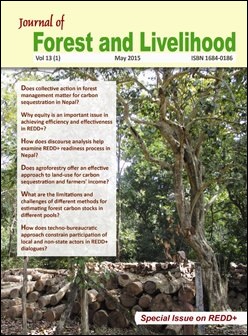Equity in Sharing the Potential Benefits of REDD+ in
DOI:
https://doi.org/10.3126/jfl.v13i1.15363Keywords:
REDD , BeneFit sharing, Equity, Communities, Community forestryAbstract
Reducing Emissions from Deforestation and Forest Degradation (REDD+) is an incentive based climate change mitigation measure that focuses on reducing carbon emissions by rewarding communities’ efforts in the conservation, sustainable management of forests and enhancement of carbon stocks. Assuming REDD+ revenues are generated, there is a question about how the benefits should be distributed. This paper uses the 3Es (Effectiveness, Efficiency and Equity) criteria in sharing the benefits of REDD+ to examine a case study in one of Nepal’s REDD+ pilot projects implemented in community forests. While concerns about equity in REDD+ are getting attention worldwide, the literature is not clear on which principle of 3Es should be given priority to achieve overall effectiveness in reducing the carbon emissions. Our research finds that equity should be prioritised to achieve efficiency and effectiveness of REDD+. Further, we find distributive equity to be the most important. Distributive equity is understood in three different ways in Nepal: rights, needs, and performance. But there is a debate on which equity should be given priority. The issues of needs vs. performance in determining what is equitable should be solved by the formulation of guidelines for how benefits should be shared at two levels in Nepal. First, the vertical distribution of benefits should be based on the ownership of carbon benefits and performance criteria. Second, at the community level, the community itself should determine the form of horizontal benefit-distribution, based on its definition of needs.
Journal of Forest and Livelihood 13(1) May, 2015, Page : 20-29
Downloads
Downloads
Published
How to Cite
Issue
Section
License
CC-BY-NC: This license allows reusers to distribute, remix, adapt, and build upon the material in any medium or format for noncommercial purposes only, and only so long as attribution is given to the creator.





